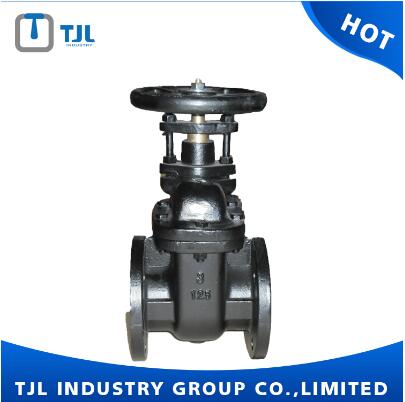- Home
- >
- Technology
- >
- The Brief Introduction Of Gate Valve
The Brief Introduction Of Gate Valve
A gate valve is a linear motion valve used to start or stop fluid flow; however, it does not regulate or throttle flow. The name gate is derived from the appearance of the disk in the flow stream.
The disk of a gate valve is completely removed from the flow stream when the valve is fully open. This characteristic offers virtually no resistance to flow when the valve is open. Hence, there is little pressure drop across an open gate valve. When the valve is fully closed, a disk-to-seal ring contact surface exists for 360°, and good sealing is provided. With the proper mating of a disk to the seal ring, very little or no leakage occurs across the disk when the gate valve is closed.
On opening the gate valve, the flow path is enlarged in a highly nonlinear manner with respect to percent of opening. This means that flow rate does not change evenly with stem travel. Also, a partially open gate disk tends to vibrate from the fluid flow. Most of the flow change occurs near shutoff with a relatively high fluid velocity causing disk and seat wear and eventual leakage if used to regulate flow. For these reasons, gate valves are not used to regulate or throttle flow.
A gate valve can be used for a wide variety of fluids and provides a tight seal when closed. The major disadvantages to the use of a gate valve are:
It is not suitable for throttling applications.
It is prone to vibration in the partially open state.
It is more subject to seat and disk wear than a globe valve.
Repairs, such as lapping and grinding, are generally more difficult to accomplish.

Gate Valve Disk Design
Gate valves are available with a variety of disks. Classification of gate valves is usually made by the type disk used: solid wedge, flexible wedge, split wedge, or parallel disk. Solid wedges, flexible wedges, and split wedges are used in valves having inclined seats. Parallel disks are used in valves having parallel seats. Regardless of the style of wedge or disk used, the disk is usually replaceable. In services where solids or high velocity may cause rapid erosion of the seat or disk, these components should have a high surface hardness and should have replacement seats as well as disks. If the seats are not replaceable, seat damage requires removal of the valve from the line for refacing of the seat, or refacing of the seat in place. Valves being used in corrosion service should normally be specified with replaceable seats.
Solid Wedge
The solid wedge gate valve is the most commonly used disk because of its simplicity and strength. A valve with this type of wedge may be installed in any position and it is suitable for almost all fluids. It is practical for turbulent flow.
Flexible Wedge
The flexible wedge gate valve illustrated is a one-piece disk with a cut around the perimeter to improve the ability to match error or change in the angle between the seats. The cut varies in size, shape, and depth. A shallow, narrow cut gives little flexibility but retains strength. A deeper and wider cut, or cast-in recess, leaves little material at the center, which allows more flexibility but compromises strength.
A correct profile of the disk half in the flexible wedge design can give uniform deflection properties at the disk edge, so that the wedging force applied in seating will force the disk seating surface uniformly and tightly against the seat.
Gate valves used in steam systems have flexible wedges. The reason for using a flexible gate is to prevent binding of the gate within the valve when the valve is in the closed position. When steam lines are heated, they expand and cause some distortion of valve bodies. If a solid gate fits snugly between the seat of a valve in a cold steam system, when the system is heated and pipes elongate, the seats will compress against the gate and clamp the valve shut. This problem is overcome by using a flexible gate,
whose design allows the gate to flex as the valve seat compresses it. The major problem associated with flexible gates is that water tends to collect in the body neck. Under certain conditions, the admission of steam may cause the valve body neck to rupture, the bonnet to lift off, or the seat ring to collapse. Following correct warming procedures prevent these problems.
Split Wedge
Split wedge gate valves , are of the ball and socket design. These are self-adjusting and self aligning to both seating surfaces. The disk is free to adjust itself to the seating surface if one-half of the disk is slightly out of alignment because of foreign matter
lodged between the disk half and the seat ring. This type of wedge is suitable for handling no condensing gases and liquids at normal temperatures, particularly
corrosive liquids. Freedom of movement of the disk in the carrier prevents binding even though the valve may have been closed when hot and later contracted due to
cooling. This type of valve should be installed with the stem in the vertical position.
Related recommendation:
Oil & Gas News in USA: Productive horizontal drilling and energy forecasts
World Water Day: Nearly 750 Million People Still Without Clean Drinking Water
Product recommendation:
ANSI B16 Metal Sealed Types Of Gate Valves
Ductile Iron Knife Pneumatic Gate Valve
Ductile Iron Knife Gate Valve Supplier




;)
;)




